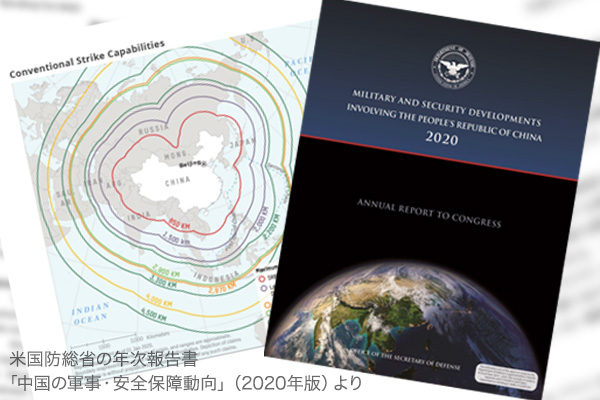China has been rapidly increasing the number of DF-26 intermediate-range ballistic missiles (IRBMs) that can be used for attacking U.S. military bases on Guam in the western Pacific directly from mainland China. In the absence of equivalent U.S. missiles, the U.S.-China missile disparity in the western Pacific is expanding. As a member of a democratic camp to counter China’s military threats, Japan will have to seriously consider accepting the deployment in Japan of new U.S. medium-or intermediate-range missiles which are now under development.
China’s fast-increasing Guam Killer missiles
The DF-26, capable of carrying a conventional or nuclear warhead, is called as a “Guam Killer” as it puts the U.S. Guam bases and nearby U.S. ships within its 4,000-kilometer range. According to the “Military and Security Developments Involving the People’s Republic of China 2020” published by the U.S. Department of Defense on September 1, the number of DF-26 launchers has reached 200, a steep rise from 80 as specified in the annual Pentagon report for 2019. Given that the number was put at 16 to 30 in the 2018 report, the number has increased two to three-fold annually.
Missiles that were test fired from mainland China into the South China Sea on August 26 as part of China’s coastal military exercises were reported as DF-26s and 1,500-kilometer range DF-21D anti-ship ballistic missiles (ASBMs). The conventional warhead DF-21D, nicknamed “Carrier Killer,” is a modified version of the DF-21 medium-range ballistic missile (MRBM) that can carry a conventional or nuclear warhead, threatening U.S. military bases in Japan. Their test firing was a clear intimidation to U.S. forces deployed in the South China Sea and the western Pacific, heightening U.S.-China military tensions.
The Pentagon report says China has a total of 700 ground-launched (ballistic and cruise) missile launchers and at least 1,250 such missiles with ranges of 500 to 5,500 kilometers. As the United States has dismantled all ground-launched missiles of these ranges including those for carrying conventional warheads under the Intermediate-Range Nuclear Forces (INF) Treaty with Russia that expired in August 2019, the country currently has no ground-launched missiles of the kind.
Japan should learn from Schmidt’s decision
The U.S. has begun the development of new ballistic and cruise missiles of these ranges following the expiration of the INF treaty. Japan’s Nikkei newspaper on August 16 reported U.S. Special Presidential Envoy for Arms Control Marshall Billingslea in a telephone interview as indicating that Japan could be a possible location of deployment for U.S. missiles now under development.
In the late 1970s during the Cold War, then West German Chancellor Helmut Schmidt determined that the Soviet Union’s deployment of SS-20 nuclear-capable IRBMs should not be left to cause an East-West military disparity in Europe. He then led the North Atlantic Treaty Organization’s double decision to deploy equivalent ballistic missiles and cruise missiles in Western Europe and seek nuclear disarmament negotiations with the Soviet Union and allowed many of such missiles to be deployed in West Germany. The decision paved the way for the United States and the Soviet Union to sign the 1987 INF treaty.
Japanese leaders after Prime Minister Shinzo Abe may have to make a similar decision as Schmidt. If new U.S. missiles are capable of carrying nuclear warheads, the Japanese government would need to allow the introduction of U.S. nuclear weapons in Japan by modifying its three non-nuclear principles, under which Japan would not possess, produce or allow the introduction of nuclear weapons into its territory. This would be a position the Japanese government should take in the current international environment.
Yasushi Tomiyama is a senior research fellow and Planning Committee member at the Japan Institute for National Fundamentals and a former foreign news editor and bureau chief in Washington, D.C., London and Bangkok for the Jiji Press.


